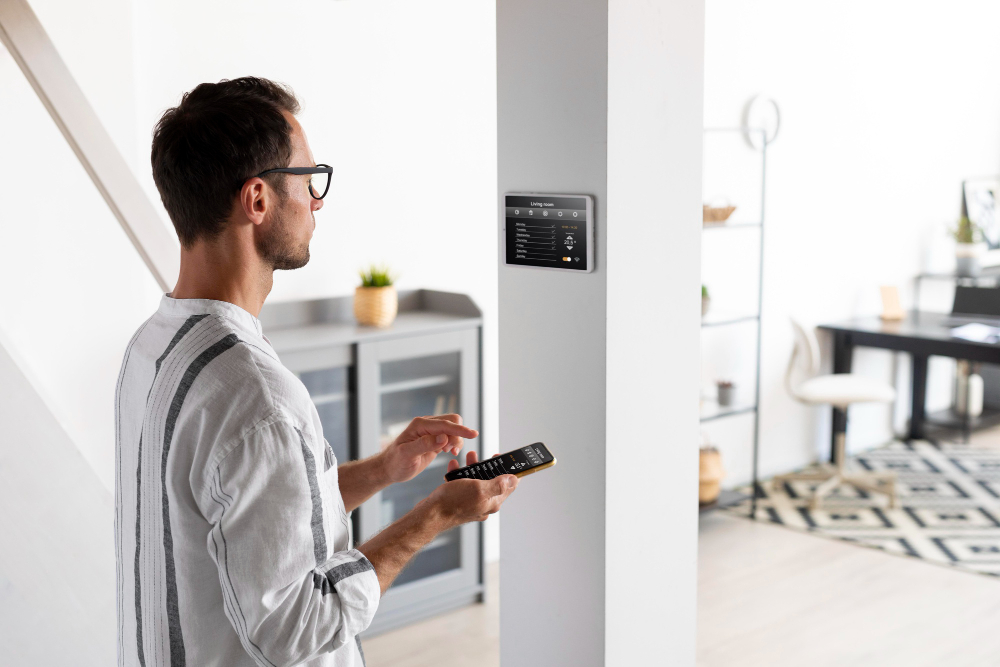Imagine waking up to natural light streaming through your automated blinds, and while you stretch, your smart thermostat already adjusts the room temperature to your ideal comfort level, saving energy without wasting energy. This dream scenario is the reality of sustainable living, powered by eco-friendly home automation systems. As climate change and rising energy costs become a major concern for homeowners, they seek ways to lower their carbon footprint without sacrificing convenience. Thanks to smart home technology, it has never been simpler or more achievable for them to live an eco-friendly lifestyle without compromising comfort. Let’s explore how eco-friendly home automation can enhance daily life while protecting our planet!
The Part Smart Home Automation Plays in Sustainability
Home automation is about smart decisions that cut waste and lessen our carbon impact, convenience is also a part of it. From smart lighting to energy-efficient appliances, automation guarantees that we make the best use of resources without compromising comfort.
-
Smart Thermostats: Balancing Comfort and Conservation in Perfect Harmony
Imagine this: while you rush out the door, you forget to turn down the heating. In a traditional home, this would waste energy all day long; but with a smart thermostat installed in your home, learning your schedule and automatically adjusting temperature when no one is present can result in significant energy savings and a decreased carbon footprint. This small change could translate to significant energy savings and a reduced environmental footprint.
Studies by the United States Department of Energy revealed that smart thermostats could reduce heating and cooling costs by 10%—not only is this great news for the planet, but it’s great for your wallet too!
-
Intelligent Lighting: Bright Ideas for Energy Efficiency
Do you remember the days that your parents would yell, “Turn the lights off when you leave the room!”? Smart lighting does the job for you. Motion-sensing LED bulbs automatically turn off when there is no one present in the room. You can also schedule them or remotely control the lights using your smartphone.
Take Emily for instance. She put in smart lights all over her home and never worries about not turning them off. In addition, LED bulbs consume 75 percent less energy than conventional incandescent bulbs. They also last longer, which reduces consumption and waste.
-
Smart Way Water Saving Automated Irrigation Systems
One of our most valuable resources is water, yet so much of it is squandered in ineffective lawn irrigation. Using soil moisture sensors and weather data to precisely ascertain how much water your plants require, a smart irrigation system eliminates this issue. This helps to save hundreds of gallons of water annually and stops overwatering.
Consider Jimmy, a dry climate dweller. He changed to a smart irrigation system that just waters his grass as needed. He discovered his water bill dropped thirty percent, and his grass has never looked better.
-
Solar-Powered Smart Homes: Utilizing Solar Energy
Imagine living in a home powered entirely by solar energy. Solar panels have become more affordable and efficient, and when combined with smart home automation they can further optimize energy use by prioritizing solar energy during daylight hours before shifting over to battery power at nighttime.
Rachel and Ross recently installed solar panels with an intelligent energy management system to power most of their home, with any excess electricity sold back into the grid. Since installing the panels, their utility bills have fallen drastically while they feel great knowing they’re contributing towards creating a greener planet.
-
Smart Power Strips: Minimizing Phantom Energy
Unbelievably, devices can take electricity even when they are shut off. This is known as ‘phantom energy’, it helps explain a startling degree of lost energy. Smart power strips switch off electricity to appliances not in use, therefore addressing this problem.
Not understanding how much electricity his game console and TV were using, Mike used to leave them plugged in constantly. He felt better about cutting waste and noticed his electricity cost dropped after changing to smart power strips.
-
Eco-Friendly Smart Appliances: Doing More with Less
Modern smart appliances are specifically designed to be energy efficient while still offering top performance. From refrigerators that adjust cooling levels automatically to washing machines that use only what’s necessary, these appliances ensure no energy goes to waste.
Amelia is an active mother who appreciates her smart washing machine, which intelligently selects the most energy-efficient cycle based on load size, saving energy consumption while prolonging clothing lifespan.
Why Eco-Friendly Home Automation Matters?
Making the switch to more intelligent green technology in smart homes isn’t only about saving money, it’s about creating an actual difference. The average family living in the U.S. produces about 7.5 tonnes of CO₂ each year. With the help of automated systems that are sustainable, this number is able to be reduced significantly.
The most appealing aspect? These technologies don’t require drastic lifestyle changes. They function behind the scenes, allowing homes to be more efficient in energy use and green without sacrificing comfort.
Beginning with Eco-friendly Automation for your Home Automation
If you’re looking to adopt the greener way of life, here’s how you can start:
- Start by installing the latest technology in thermostats and lighting. They are simple to set up and provide immediate energy savings.
- The best way to save money on energy-efficient appliances is to find ENERGY Smart devices, with STAR ratings, which reduce the energy consumption.
- Change to a sophisticated irrigation system to save water and keep your garden lush.
- Look into solar panels using intelligent energy management to reduce dependence on grids and utilize renewable energy.
- Utilize smart power strips to eliminate phantom energy waste easily.
Conclusion:
Sustainable life need not be difficult. Eco-friendly home automation makes greener decisions simpler than they formerly would be. Whether it’s smart lighting, energy-efficient appliances, or solar-powered solutions, these technologies are helping homeowners cut waste, save money, and assist in creating a better Earth.
Leading the way in offering premium smart home solutions that give sustainability first priority without compromising comfort are companies like HomeTech1. Therefore, now is the ideal moment to investigate your possibilities if you want to make your house greener and smarter. Sustainable life is here; why not join in its future?


